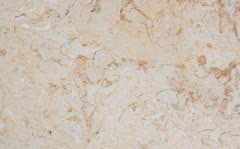The word ‘marble’ derives from the Greek marmaros “shining stone”. This stem is also the basis for the English word marmoreal meaning “marble-like”.
Marble is a metamorphic rock resulting from regional contact metamorphism of sedimentary carbonate rocks, either limestone or dolomite rock. This metamorphic process causes a complete re-crystal-lization of the original rock in to an interlocking mosaic of calcite, aragonite and / or dolomite crystals. The temperatures and pressures necessary to form marble usually destroy any fossils and sedimentary textures present in the original rock. Pure white marble is the result of metamorphism of very pure Limestone’s. The characteristic swirls and veins of many coloured marble varieties are usually due to various mineral impurities such as clay, silt, sand, iron oxides, or chert which were originally present as grains or layers in the limestone. Green coloration is often due to serpentine resulting from originally high magnesium limestone or dolomite rock with silica impurities. These various impurities have been mobilized and re-crystallized by the intense pressure and heat of the metamorphism.
Natural patterns on the polished surface of “landscape marble” can resemble a city skyline or even trees. Some historically important types of marble, named after the locations of their quarries, include: Thassos (Greek) Thassos is one of the most known Important quarries relating to the Prehistoric, Neolithic and Archaic era have been found in Thassos. There is also Paros and Penteli in Greece. Even since in antiquity, Penteli has been famous for its marble which was used for the construction of the Acropolis and other buildings of ancient Athens. Penteli marble is flawless white with a uniform, faint yellow tint, which makes it shine with a golden under sunlight. The ancient quarry is protected by law and used exclusively to obtain material for the Acropolis restoration project. The roadway used to transport marble blocks from the quarry to the Acropolis in the past was a continual downhill and followed the natural lay of the land.
Marbel can also be found in Italy in the Carrara and Luni regions. Carrara marble has been famous since the times of ancient Rome. The Pantheon and Trajan’s column in Rome are constructed from it. Many famous sculptures of the renaissance, such as Michelangelo’s David, were carved from Carrara marble. The stone tradition meets with the most up-to-date techniques of the stone industry. All this, in deep connection with the territory and a back ground of more than one hundred companies and almost one hundred quarries working within the sector.
The derivation for the word ‘Carrara’ possibly comes from the ancient term “Kar” (stone). Ancient Romans quarried the marble, loaded it onto ships at the port of Luni and took it to Rome by sea.
White marbles, like Carrara in Italy and Royal white and Bejing White in China, have been prized for sculpture since classical times. The preference for this material comes from the softness, relative isotropy, homogeneity and a relative resistance to shattering. Also, the low index of refraction of calcite allows light to penetrate several millimetres into the stone before being scattered out, resulting in the characteristic ‘waxy’ look which gives ‘life’ to marble sculptures of the human body.
Subscribe to:
Post Comments (Atom)








No comments:
Post a Comment